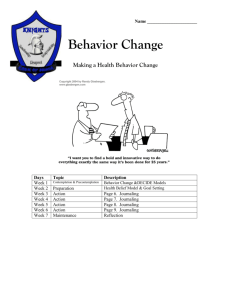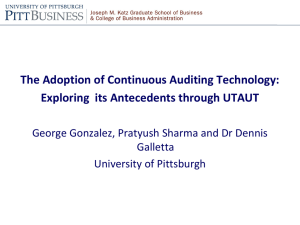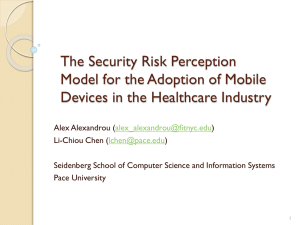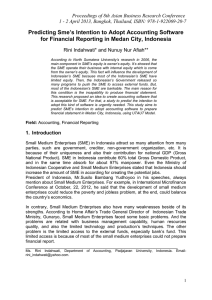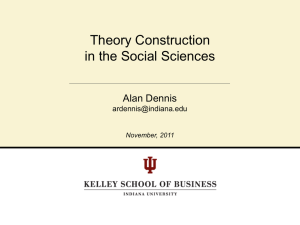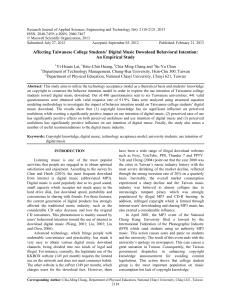donaldson_defense2
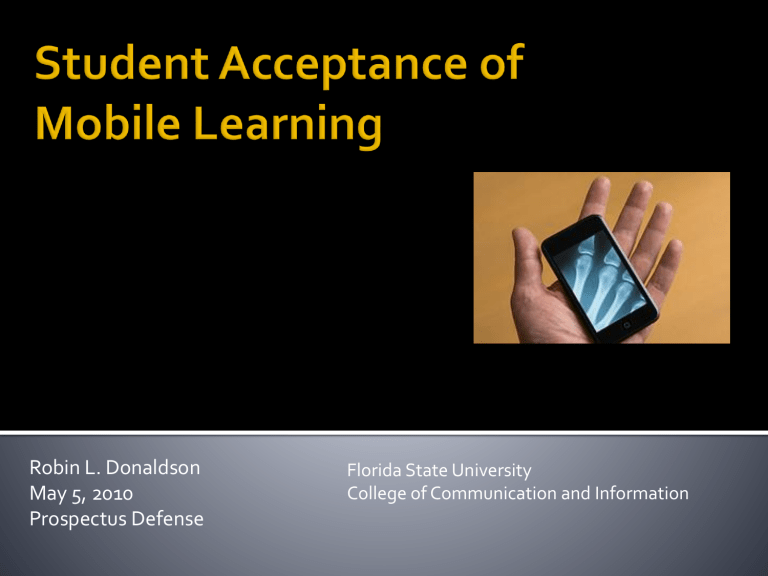
Robin L. Donaldson
May 5, 2010
Prospectus Defense
Florida State University
College of Communication and Information
Wireless delivery of learning content through handheld device – any time & anywhere.
(Tsvetozar Georgiev, et al., 2004)
Personal Use
32% use a cell phone for Internet access
19% use mobile Internet access
Learning & information resources
Higher Education
Initial stages
Learning & information resources
Digital divide
Identifying value and determinants
Technology acceptance research most mature research area in IS literature.
Limited research using technology acceptance theories
Unique characteristic of mobile learning
IS models may not fully address mobile learning
Use technology acceptance theory as a theoretical framework to examine the determinants associated with community college students’ acceptance and use of mobile learning.
TAM & TAM2 –
Do not consider variables that may negatively impact behavior (system characteristics, training, support)
Are not able to explain as much of the variance in user behavioral intention to use and actual use as UTAUT.
Failure to acknowledge individual differences such as age and gender
TAM3 -
Lack of supporting research
Non- academic participants and information systems
Age and gender
Explain as much as 70% of the variance in user behavioral intention to use and actual use
Performance Expectancy
▪ “the degree to which an individual believes that using the system will help him or her to attain gains in job performance”
Effort Expectancy
▪ “the degree of ease associated with the use of the system”
Social Influence
▪ “the degree to which an individual perceives that important others believe he or she should use the new system”
Facilitating Conditions
▪ “the degree to which an individual believes that an organizational and technical infrastructure exists to support use of the system”
Population being studied
Community college in north Florida
GED or Highschool degree
Large percentage required to take developmental courses &
SLS 1510
Facilitating conditions
Diverse ages
Diverse access levels to technology
Participants
Convenience sample
All students enrolled in college credit courses
Self-management of learning is “the extent to which an individual feels he or she is selfdisciplined and can engage in autonomous learning”
Voluntariness of Use
“the degree to which use of the innovation is perceived as being voluntary, or of free will”
Perceived playfulness -the extent to which the individual
perceives that his or her attention is focused,
curious during interaction,
finds the interaction intrinsically enjoyable or interesting.
Quantitative descriptive and comparative research design
Utilize cross-sectional survey data
Mixed Method
General
Convenience sample
Cross sectional
Course and participant availability for interviews
Survey
Statistical significance within the design does not imply cause-and-effect relationships
Self reported
Does not allow the researcher to obtain an in-depth understanding
Interviews
Protocols and transcribing is time consuming
Participants can be influenced by researcher
More difficult to analyze
Coding and theme development time consuming
General
add breadth and depth of understanding of research questions
corroboration of research findings
Survey
cost effective
producing precise descriptions of large populations
,
collection of a data from a large number of participants
repeated in other research or to assess if any changes that have taken place
Interviews
can probe for additional responses
can provide clarity to questions
observations of the respondent can be recorded
gain a more in-depth understanding of participants’ survey responses
Procedure
Sequential explanatory strategy
Pre-existing survey
▪ Cross sectional
Interviews
UTUAUT survey instrument, perceived playfulness, self-management of learning, voluntariness, demographic and opinion related
Demographic and opinion-related questions
Gender/age
access to a home computer
enrollment in developmental courses;
Internet experience;
frequency of use of mobile devices;
types of information, and library and learning resources currently used and interested in accessing
Research Question 1. Are the following independent variables significant predictors of the behavioral intention to use mobile learning: performance expectancy, effort expectancy, social influence, facilitating conditions, voluntariness, perceived playfulness, and self-management of learning?
Analysis: multiple regression
Research Question 2. Are the following independent variables significant predictors of the use of mobile learning: performance expectancy, effort expectancy, social influence, perceived playfulness, self-management of learning and facilitating conditions?
Analysis: multiple regression
Why? Used to explain relationships - determine if predictor variables are predicting a continuous dependent variable.
Research Question 3. Is there a statistically significant difference between males and females on the behavioral intention to use mobile learning?
Analysis: independent samples t-test
Research Question 4. Is there a statistically significant difference between males and females on the use of mobile learning?
Analysis: independent samples t-test
Why? comparing two groups gender and intention to use or actual use.
Research Question 5. Are there statistically significant relationships among the participants’ age, behavioral intention to use mobile learning and the actual use of mobile learning?
Analysis: bivariate Pearson correlations (r)
Why? seek to determine if age is related to intention to use or actual use mobile learning.
Research Setting and Population, and
Participants
Convenience sampling
Selecting participants
Courses targeted
Semi structured questions
Protocol
Interviewer
Script
Face-to-face, online, or phone
Research Question 2 - Predictors of use
Interview Question 1. What factors influence your actual use of mobile learning?
What factors prevent you from using mobile learning?
Research Question 4 - Difference in use between males and females
Interview Question 2. Do you believe there is a difference in the amount of time men spend on mobile learning when compared to the amount of time women spend on mobile learning ? Please explain your answer.
Research Question 5 - relationships among the participants’ age, intentions, and actual use
Interview Question 3. Do you believe age affects your actual use of mobile learning? Please explain your answer.
Content Analysis
Organize
Code the
Categorize
Narrative discussion
Interpretation to assign meaning





